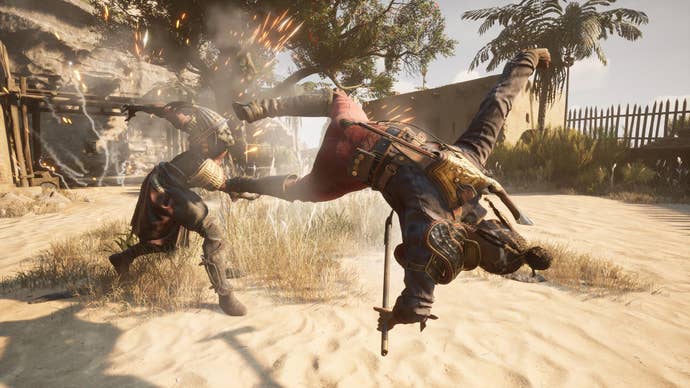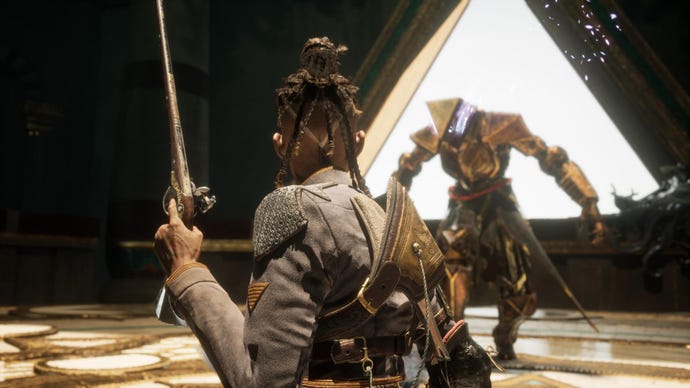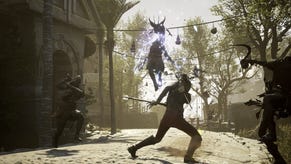How A44 is taking on AAA with Flintlock – massive ambition, the journey from Ashen, and musical animations
Flintlock: The Siege of Dawn is the kind of game you’re going to hear about a lot this year.
A44 is a bit of an unusual studio. The New Zealand developer first burst onto the scene in 2018 with Ashen, a Souls-like action RPG with a distinct, stripped-down art style. One look at Ashen and you knew exactly what it is, but spending time with it is what ultimately reveals a much deeper game than it first appears.
A44 is back with Flintlock: The Siege of Dawn, a major new project for the small team. Flintlock is everything Ashen was, and everything it wasn’t. It too is an action RPG, with demanding combat inspired by Souls games. Between missions, you’ll go back to a hub area that you’ll get to see grow and evolve over the course of the campaign, shaped by the people you come across in your travels and those you bring back.
But it doesn’t look anything like Ashen. Flintlock has the look of an expensive, AAA game with stunning – but more traditional – visuals. It’s set in an open world where you get to explore multiple locations inspired by the studio’s native New Zealand, and you’ll be doing it alongside an AI companion who’s with you all the way. Flintlock has a more realised narrative, with believable character animations, and a story more clearly told.
One aspect in particular about Flintlock stood out to me: its setting. See, the name is not a coincidence. Like Dieselpunk, Steampunk and other fantasy subgenres, Flintlock is also its own fiction.
“It’s kind of fairly accurate historical re-enactment mixed with fantasy. So, in this case, instead of Steampunk, the machines kind of meld with the magic to some degree,” creative director and studio CEO, Derek Bradley, explains.
“Everything is kind of down quite in the mud, in the dirt – the dirt under everyone’s fingernails. Flintlock fantasy is very much that.”
Whether or not you know what this particular brand of fantasy is about, it all translates to a world that mainly fights using melee weapons, while relying on early firearms and some magic when the need calls. But it’s all very treacherous; magic is dark and could lead its user down a certain path, and Flintlock rifles aren’t exactly the reliable modern-day weaponry.
This combination makes for quite a unique opportunity to build varied, exciting gameplay scenarios that could still demand a certain level of skill from the player. Like Ashen, Flintlock: The Siege of Dawn is also taking cues from Souls combat, but it’s pushing those familiar concepts in unusual directions.
Bradley outlines the team’s design mantra for combat this time around. “The thing that we really are drawn towards is the sense of rhythm, the sense of commitment to your moves when you play a Souls-like,” he says.
“Which is to say, we go pretty deep on this, almost writing out our [moves] like music before we animate them. So they're actually done with a beat structure.”

But this isn’t all high-level jargon; A44 is allowing this process to inform the game’s encounter design.
“It's more about the dance than it is about winning,” Bradley jokingly declares. “We sort of describe our axe combat, our melee combat, as kind of like the words in a sentence and then the gunplay is kind of like the commas and the full stops in the sentence.”
In practice, this translates to something like this: “If you do an axe hit, and then another axe hit, and then you pull out your Flintlock pistol - it all actually animates perfectly smoothly, like you're this kind of very skilled gunslinger that's moving through these things.
“And if you follow that gun shot with another axe swing, there's a specific bespoke animation to make it come perfectly out of that. The whole thing is kind of like a symphony of moves. And then there's the bigger, magical ultimates that you can do to kill groups of enemies, or they turn you into a lumbering behemoth or do all those sorts of really interesting things as well that break it up.”
Though Flintlock’s combat is designed for this jack-of-all-trades approach, the game’s customisable skill tree allows for more specialised builds. You can spec into gunplay, or lean heavily into magic.
Co-op was one of Ashen’s most defining aspects, but it’s not coming back for Flintlock. Instead, you’ll be accompanied by Enki, a fox-like creature who’s useful in combat, but his role in the story is another element that sets the way the narrative unfolds apart from how it did in Ashen. Bradley suggests that co-op might return in future games, however, so the team has not abandoned it.
In some ways, dropping co-op helped Flintlock grow its technical ambitions, particularly for a small team. This is a larger game with more distinct locations, challenging main and side boss encounters, a more varied arsenal of weapons, more involved combat, and a longer average length of around 40 hours. Even finer details, like character animations and cinematics, rely on more advanced techniques, such as Unreal Engine’s MetaHuman system.
You can imagine how much harder it would have been to maintain all of that in co-op.

But the size of game worlds and how long they take to finish are rarely exciting metrics in the current era. It’s all about how you utilise that world, and how long you can continue to surprise players and make it interesting to explore hours into it.
Elden Ring is the current benchmark in that area, but Ashen doesn’t get enough credit for how much it did with a fairly simple presentation. With Flintlock, A44 wants to keep that sense of discovery going for as long as possible.
“I think the way you kind of lead the player's eye is almost like this vocabulary that you're working through,” Bradley eloquently puts it.
“So whenever I'm in playthroughs with the team, if I kind of just describe what I'm seeing in that vocabulary and be like, well, now I'm looking at this and it's drawing my eye towards that and this thing's making me feel like I want to go this way. If the designer goes, ‘Oh, I didn't actually want you to go there,’ at least I've expressed to them and they can see what that kind of vocabulary is.”
The idea of treating it like a conversation also extends to enemy design. Bradley explains that each enemy doesn’t just need to look interesting, it needs to tell you something about itself. This can be a certain geometric shape that’s reflected in their silhouette, for instance.
Flintlock: The Siege of Dawn is coming to last and current-gen consoles, and while Bradley can’t share specifics about resolution and performance targets, he says to expect the game to be a showcase for the new machines.
Xbox Series X/S owners won’t have to buy the game to find out, too, because it’s launching on Xbox Game Pass. It will also arrive on PC Game Pass at launch.





